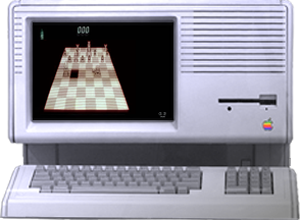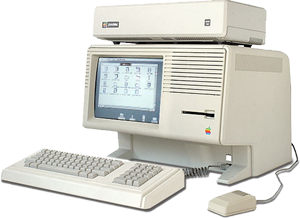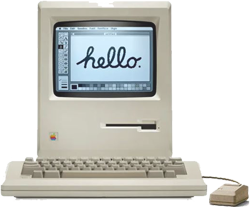
The Lisa is a rare GUI-based business computer released by Apple Computer, Inc. in 1983. It came in two versions, Lisa I and Lisa II, while the Lisa 2/10 was later modified and rebranded as the Macintosh XL. The Lisa was more advanced than the later Macintosh 128K and 512K, but it was significantly more expensive. The Lisa 1 was sold for $9,995 -equivalent to approximately $29,000 today- while the Lisa 2 was offered at a lower price.
- An estimated 10,000 Lisa units were sold, with only around 500 being Lisa 1 models
- Lisa was officially discontinued in 1985. In 1986, Apple offered Lisa owners the opportunity to trade in their computer and purchase a Macintosh Plus with a hard disk for $1,498
![]() LISA AT A GLANCE
LISA AT A GLANCE
Apple argued that LISA was an acronym for "Locally Integrated Software Architecture", however, Lisa was also the name of Steve Jobs' first daughter (born in 1978).
- Motorola 68000 CPU @ 5 MHz
- 1 MB RAM and up to 2 MB (Lisa 2 offered 0.5 MB)
- 16 KB Boot ROM
- 5 MB hard drive (Lisa 2 offered 5/10 MB)
- 12” built-in display (720 × 364, monochrome)
- GUI (Graphical User Interface) and a hard-disk-oriented operating system
- Cooperative multitasking and virtual memory
- Protected memory (very innovative back then)
- Two 5.25-inch double-sided FD drives (Lisa 2 used a single Sony 400k drive)
- Expansion Port (Unlike the original Macintosh)
Note that the iconic Motorola 68000 CPU was later used in Macintosh (@ 7.89 MHz) but also in Commodore Amiga 500/600/1000/2000/CDTV, in Atari ST/STE, and even on arcade machines and the Sega Mega Drive.
The Short but Interesting History of Lisa Computers
 Lisa-1
Lisa-1
The Lisa project began in 1978, with Apple investing $50 million in its development and assembling a team of 10 engineers. Over time, more than 90 people contributed to Lisa’s design, plus an extensive marketing team.
In 1979, Steve Jobs visited Xerox PARC and was inspired by innovations such as the mouse-driven graphical user interface. By late 1979, Jobs negotiated a deal with Xerox, trading Apple stock for permission to study their research. It’s fair to say that while Apple gave birth to Lisa, Xerox was its true predecessor.
Lisa was repackaged and sold as Lisa 2 at a lower price tag.
Lisa 2
Lisa 2 was released in January 1984 at a significantly reduced price, ranging from $3,495 to $5,495. To cut costs, Apple replaced the dual floppy drives with a single 400K Sony microfloppy and reduced memory to 0.5 MB. There were two variants: one with a 5 MB hard drive (Lisa 2/5) and another with a 10 MB drive (Lisa 2/10).
- In early 1985, the Lisa 2/10 was rebranded as the Macintosh XL, allowing it to boot into Macintosh mode. It was discontinued in 1986
- In 1989, Apple disposed of 2,700 unsold Lisa computers in a landfill in Logan, Utah, as part of an inventory write-off for tax purposes
Lisa Usage & Notable Applications
Lisa incorporates two modes:
- The Lisa Office System (the GUI environment) includes LisaCalc, LisaWrite, LisaDraw, LisaGraph, LisaList, LisaProject, and LisaTerminal.
- The Workshop (a program development environment, using a GUI text editor)
NASA was Apple Lisa’s greatest customer. Lisa was used by NASA for project management (LisaProject).
In April 1984, Apple introduced MacWorks, which allowed the Lisa computers to run Macintosh software applications. In addition, Santa Cruz Operation (SCO) released Microsoft XENIX for Lisa 2 and the Multiplan spreadsheet on Lisa XENIX.
- In 2018, the Computer History Museum announced it would release the source code for Lisa OS.
■ Apple Lisa 1/2
G.P. for Binaryvalue.com 2022 (c)
Sources:
![]() > FIND MORE
> FIND MORE
□ MODELS
» Apple Lisa
» Apple II GS
» Apple Mac
» Color Classic
» Macintosh LC
» iMac G3














 TOP-10 APPS
TOP-10 APPS TOP-20 GAMES
TOP-20 GAMES
